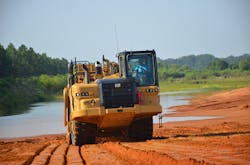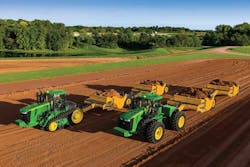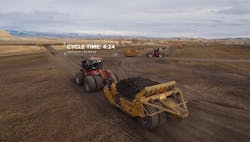Scrapers are either motorized and self-propelled or towed. Each has its advantages. One advantage of a towed scraper system is the efficient way it moves soil and reaches design grades. The drawn scraper design aids with efficiency. Its multiple tires combined with the high weight of the machine ensure high levels of compaction without using another piece of equipment. On the other hand, with self-propelled scraper systems, one machine with one operator is required to complete the job.
Scraper Design Basics, Configurations, and Types
Each is more useful in specific situations. When the soil content is high density (such as heavy wet clays) or is strewn with large rocks, boulders, or tree stumps with big rocks and/or stumps, a self-propelled scraper has difficulty or at least needs an additional push from a dozer or similar piece of equipment. However, scrapers of any kind often operate better in soft soils than other heavy equipment. So, for these situations a towed scraper or a pushed self-propelled scraper is preferable. Furthermore, when the soil is light to heavy, with moderate moisture and few rocks, a self-propelled scraper operating on its own may be preferable.
Towed scrapers have other advantages. It is a simpler, more user-friendly configuration that requires less operator training. The additional tractor can also be used for other onsite tasks. The basic configuration can be expanded from single scrapers to trains of two or three scrapers. They are often more maneuverable than self-propelled scrapers and can operate better in wet clayey soil due to less weight per tire. It also typically loads in half the time as a motorized scraper.
Specialized scraper equipment and configurations are used for particular functions. An open hopper usually requires a bulldozer or similar piece of equipment to assist in loading whereas an elevating scraper can perform self-loading and requires no pushing. Scrapers working in tandem can operate with greater power and better traction even in slippery conditions or steep terrain. For example, tandem push-pull scrapers combine two scrapers into one cutting edge with the push-pull attachment allowing for the rapid loading of both machines. A hopper can be equipped with an internal auger that pulls material upward, assisting in loading. Pull scrapers are dragged by articulated dump trucks, farm tractors, or bulldozers. Carry-all scrapers utilize a gate when transporting materials and a pivoting hopper for dumping the scraped soil. These can be combined with waling tandems which reduce uneven scraping and irregular finished surfaces. Hoppers with gated ejectors allow for rapid dumping by forcibly ejecting the soil material from the hopper. More advanced control technologies include the use of GPS or laser control operations.
Scrapers operate in several power zones. The high-power zone utilizes high torque to maximize applied force and overcome difficult site conditions or hard excavation materials. The slow speed zone is used when power is more important than speed of operations, on average or typical job sites. The high-speed zone is utilized when ground conditions are easy and the scrapers can operate on paved and well-maintained haul roads instead of rough, open countryside.
The Advantages of Using a Scraper: Measuring and Comparing Productivity
But the real job performed by scrapers is to give operators, developers, and fleet owners more options and solutions for earthwork problems. Loading, hauling, and dumping are performed differently by scrapers than other types of earthmoving equipment. Scrapers (either self-propelled, towed, or pushed) load themselves with a cycle time measured in minutes. Articulated dump trucks take more time to load, being fed soil from the buckets of excavators. Scrapers can operate effectively in a wide variety of surface conditions and specialized tasks (like roadway maintenance or construction). Articulated trucks can move faster but only over good terrain or well-maintained roadways. While dumping, scrapers spread their loads out evenly and smoothly while on the move. They can follow up with in-place compaction using their tires. Trucks, on the other hand, dump in one spot, creating a pile that needs to be managed by other earthmoving equipment like dozers.
In short, for appropriate applications, scrapers are far more efficient for the task and require few, if any, pieces of support equipment. This efficiency and cost-effectiveness show up prominently in fuel consumption figures. Scrapers, especially those powered by improved transmissions, can see a fuel consumption reduction of 30%.
Operational flexibility is another advantage that scrapers provide. They can do it all: dig, load, haul, dump, and spread. Not using scrapers would require a minimum of three different machines for these operations. One scraper can do it all provided it is properly sized in terms of horsepower, the type of material being excavated and moved, the amount of material to be managed, and the distance the scraper must travel to complete a work cycle.
Earthmoving contractors are in business to make money for the same reason that anyone else is in business. Five factors affect earthmoving costs and determine earthmoving profits: hauling distances (the shorter the better), minimizing the number of times the earth is handled (preferably only once), minimizing energy costs (by maximizing fuel efficiency per unit of earth moved), maximizing the capital return on earthmoving equipment (don't let equipment sit idle by minimizing job site downtime), and using equipment appropriate for field and weather conditions (by using equipment that can operate effectively in a wide variety of work environments).
Compared to the multiple pieces of equipment that must be used for the same task, scrapers check all five boxes. As for hauling distances, scrapers outperform other equipment for most applications. While dozers are best for hauling (actually pushing) distances under 200 feet, and a truck excavator combination is more useful for distances greater than 2,000 feet (and to haul excavated material offsite), scrapers are best for all distances in-between—which represents most job sites. In doing so, a scraper needs to handle soil only once, whereas other equipment combinations require separate loading operations, hauling movement, and stockpile management—requiring several pieces of equipment to handle the soil (minimum one each excavator, articulated truck, and dozer). In contrast, a tractor-pulled scraper needs only a farm tractor and the towed scraper, a much smaller capital investment for the same amount of work.
As the saying goes, time is money. Conventional earthwork with multiple pieces of equipment can require—not including site-specific haul times—three minutes for loading and dumping (one minute for loading a 15-cubic-yard truck with a medium-sized excavator, two minutes to dump and spread with a dozer. By comparison, a scraper pulled by a 350-hp tractor can take only half a minute (20 seconds to cut and load 15 cubic yards and 10 seconds to eject soil to finish grades).
Major Suppliers
Caterpillar, Inc. Cat Wheel Tractor-Scrapers (WTS) are high-production machines. Their wide versatility and durability give them an advantage on volume material moving projects. Wheel tractor-scrapers can work in material that ranges from sand to ripped rock 24 inches or less in size. The scraper line includes single- and twin-engine models, allowing the customer to select the proper model to meet the grades and rolling resistance they will encounter on job sites in their region. Operational speed is a primary feature of Cat scrapers. Their wheel tractor-scrapers provide several advantages, including the ability to move material quickly with minimal prime movers and support equipment. The ability to load the material and place it with a single machine makes it a very economical hauling system.
New technologies are always being added to the Caterpillar scraper line. This is part of their ongoing effort to deliver continuous improvements to their customers. The technology is a true game-changer for improving the operator experience, reducing operator workload, and leveraging automatic Cat Grade Control to minimize moving material more than once. To summarize, we have a machine that can move more material with less operator effort, and we can also ensure the machines are moving the correct amount of material. Rework is one of the fastest ways to lose money on a project.
John Deere. According to Mark Shea (product consultant, John Deere Construction & Forestry), John Deere provides a range of scraper system solutions, with various configurations, for contractors’ needs. John Deere offers scrapers in two-, four-, and six-tire configurations to minimize rolling resistance (two-tire configuration) or for the least amount of ground pressure (four- or six-tire configuration), in addition to tractors with single or dual wheels, two tracks, or four tracks. With the widest range of both tractor and scraper configurations, the John Deere scraper system provides consistent compaction in the fill regardless of the material type.
Another key aspect of obtaining good compaction is how the lifts of material are placed before compaction. With a scraper, the height at which the material is placed is directly controlled by the operator. If the scraper is not equipped with a grade control system, this height is solely at the discretion of the operator, leaving a lot of room for inconsistencies. An exclusive feature on the John Deere scraper system that eliminates inconsistency in the fill lift is Autoload. By allowing the operator to preset the fill and dump heights, Autoload provides consistent heights during loading and unloading with a single click of a button on the command arm.
One of the advanced scraper technologies from John Deere is the Earthmoving Productivity System, introduced at CONEXPO-CON/AGG in March 2020. Developed by John Deere and designed to improve operator efficiency, the Earthmoving Productivity System determines the amount of volume being loaded into the scraper in real-time and then transfers that critical data back to the operator via the in-cab display, and to the site manager via JDLink. Through the in-cab display, operators can see live video from a stereo camera looking down in the bowl, which is beneficial when loading multiple scrapers. In addition to the live video, the system tracks key data points, such as fuel burn and cubic yards, helping to improve efficiency and increasing job site success. Through the data collected by the system, job site managers can accurately track daily products, compare operator efficiency, and gain a more complete picture of the overall job site performance.
K-Tec offers contractors the largest construction pull-pan scrapers in the market with durable scrapers ranging from 28 to 63 cubic yards. Fleets of K-Tec’s high-capacity scrapers are prevalent in the heavy construction market around the world. The construction-grade K-Tec scraper performs in almost any condition from rock quarries to the muddiest, softest soil conditions in North America, to the sands of Australia and Saudi Arabia.
K-Tec revolutionized the scraper market by releasing the first-ever ADT Scraper concept. K-Tec was the pioneer to develop the technology of hooking up an articulated dump truck to pull a scraper. It is a massive advantage for a contractor to be able to use an existing fleet of ADTs and convert them into efficient, self-loading scraper haulers. Not only can the trucks be utilized for a new purpose, but also that same truck driver can now easily transition into an effective scraper operator, behind the same familiar wheel to add efficiency and productivity to the project. K-Tec’s scraper advancements have been to the benefit of scraper operators. K-Tec has recognized that it has been hard for contractors to find qualified scraper operators, as traditionally, the position was a complex task, and it was ergonomically uncomfortable having to twist and bounce in the cab. The great operating benefit with using an ADT as the scraper power-unit is that using a scraper is now a comfortable, forward-facing operation. The truck’s 6-Wheel Drive, along with K-Tec’s Scraper Automatic Cushion Ride System, acting as a shock absorber, provides for a smooth ride for the operator, plus the ability to travel faster on the haul road for increased productivity.
Since its inception in 2000, the K-Tec scraper has been designed as a technologically advanced machine. K-Tec has spent years of research and development in refining the optimal earthmoving scraper and leading the industry in revolutionary product technologies. K-Tec’s proprietary automatic cushion ride system takes the shock out of fully-loaded scrapers. The ADT truck, with a 6-wheel drive and longer wheel base, has a much smoother ride compared to traditional motor scrapers or Ag tractors. Furthermore, the use of a full-suspension ADT truck can be like operating on a cloud.
Further precision technology can be easily added to the operator’s dashboard, as K-Tec scrapers come Trimble GPS-ready from the factory. This allows for Trimble’s kit to be simply installed for quick GPS integration for finish grading applications. Many efficiencies may be gained by using a GPS system on a scraper, as the operators know how much specific material to directly move from one area of the job site to the other, for reducing multiple movements of material.
K-Tec’s Telematic system beams key earthmoving performance indicators from the job site to the cloud, for a software dashboard accessible to a contractor’s team for assessing the information needed to make the smartest business decisions for a massive advantage in earthmoving. In addition to the proprietary software developed, a hardware kit is also integrated with K-Tec’s scraper and onboard computer and monitor display equipment.










